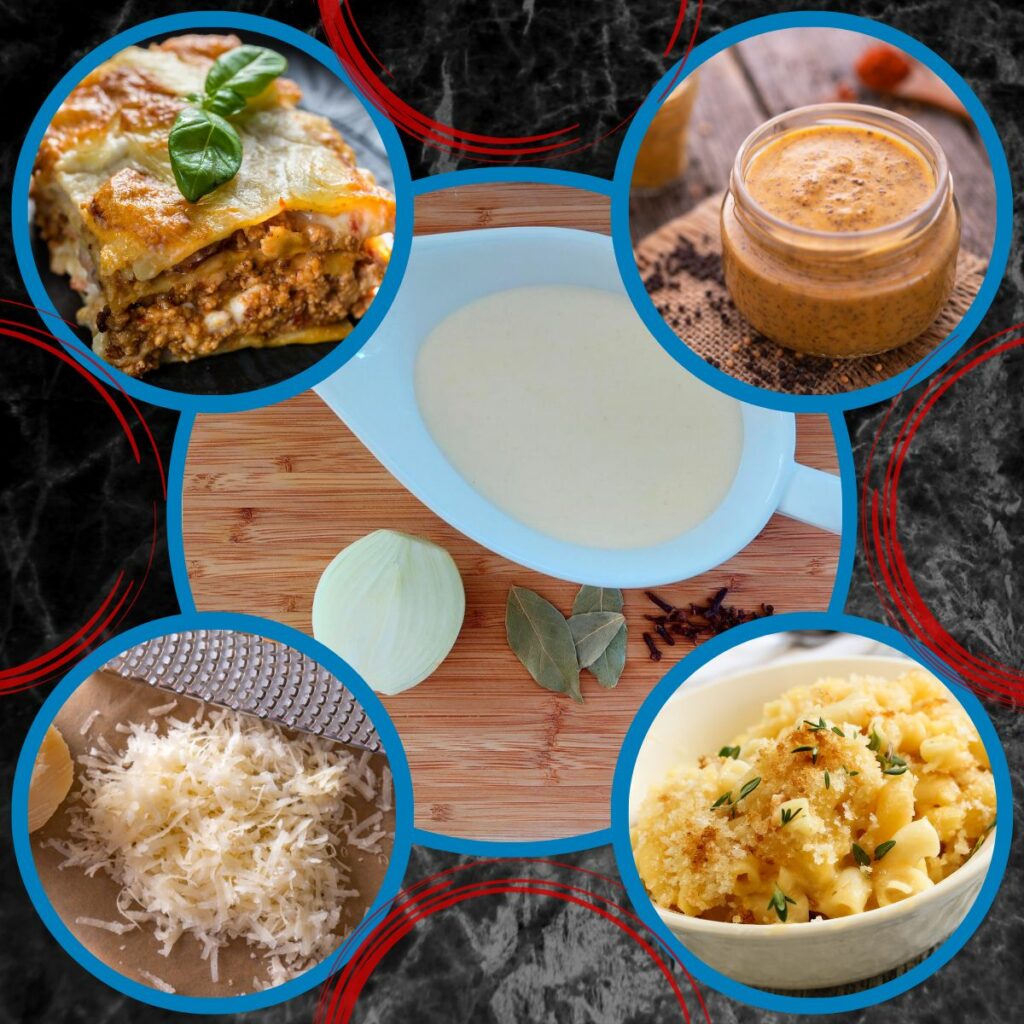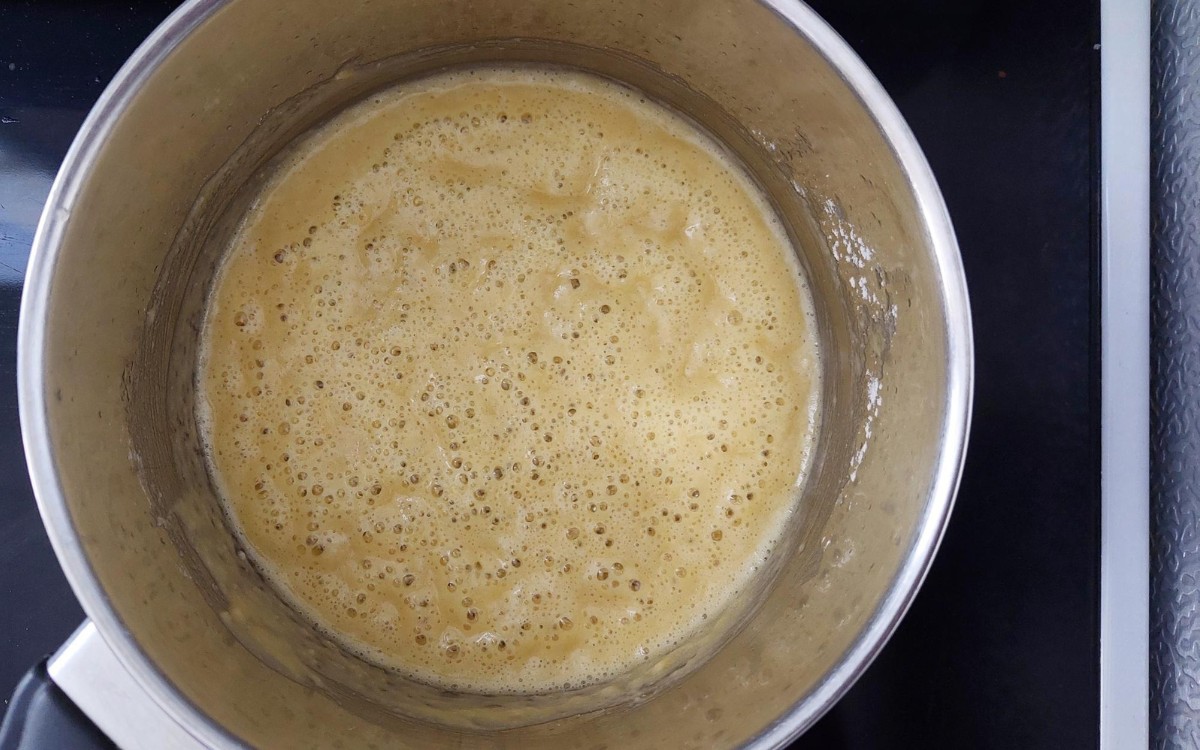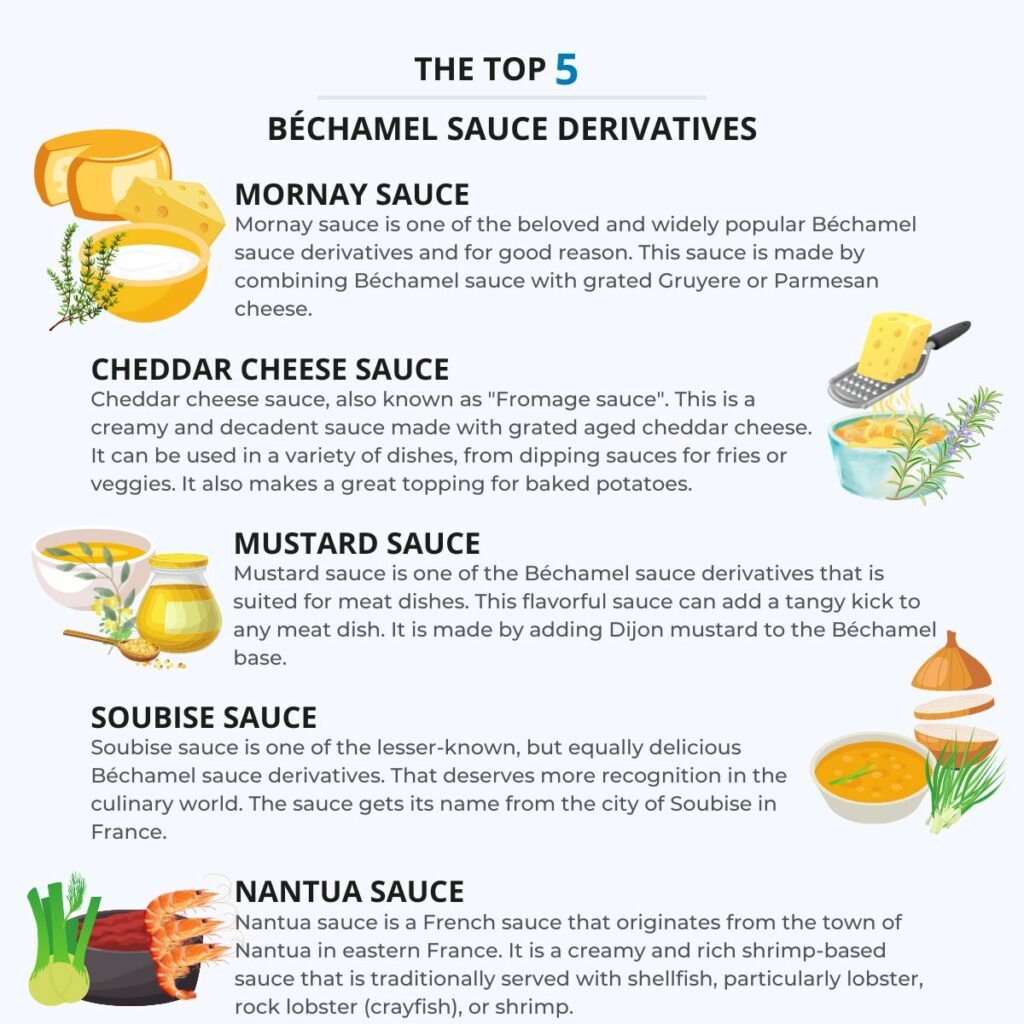Privacy Policy | Terms and Conditions | Disclosure Statement | License Policy
COPYRIGHT © 2024 | NUMBER 8 COOKING | ALL RIGHTS RESERVED.

Privacy Policy | Terms and Conditions | Disclosure Statement | License Policy
COPYRIGHT © 2024 | NUMBER 8 COOKING | ALL RIGHTS RESERVED.

Privacy Policy | Terms and Conditions | Disclosure Statement | License Policy
COPYRIGHT © 2024 | NUMBER 8 COOKING | ALL RIGHTS RESERVED.
If you’re a home cook who takes pride in creating sauces from scratch, then these 5 essential Béchamel sauce derivatives are for you. This is a must-read!
Béchamel sauce, a classic French mother sauce and the foundation of many beloved sauces is the perfect base for a range of delectable derivatives.
ADVERTISEMENT CONTENT BELOW
And, we’re not just talking about one or two tweaks. With a few extra ingredients and adjustments, this versatile sauce can be transformed into something entirely new and exciting.
In this blog post, we’re diving into the world of Béchamel sauce derivatives, including the popular Mornay, Cheddar Cheese, and Mustard sauces. As well as the lesser-known but equally delicious Soubise and Nantua sauces.
Are you ready to embark on this saucy journey with me? You will be elevating your culinary sauce knowledge with these 5 essential Béchamel sauce derivatives.

ADVERTISEMENT CONTENT BELOW
Let’s start with the basics, Béchamel sauce is a creamy, velvety sauce made from a white roux of butter and flour. Then hot milk is whisked into the roux to finish the sauce.

Béchamel sauce is used as a base for many dishes. Including lasagna, mac and cheese, and gratins. But what if you wanted to change things up a bit? That’s where Béchamel sauce derivatives come in.
Here are our 5 favorite Béchamel sauce derivatives. These we regularly use in our kitchens as an addition to a dish or as a sauce to complete a dish.
How to season food is an art that combines creativity, intuition, and a deep understanding of flavors. That transforms ordinary ingredients into extraordinary culinary masterpieces.
Mornay sauce is one of the beloved and widely popular Béchamel sauce derivatives and for good reason. This sauce is made by combining Béchamel sauce with grated Gruyere or Parmesan cheese.
Resulting in a deliciously creamy and cheesy concoction that’s perfect for topping pasta dishes, vegetables, and a variety of meats like pork, chicken, fish, and of course lobster.
This sauce is so versatile that it’s a staple in our kitchens. And we use it generously to add a touch of cheesy goodness to our favorite dishes.
Chefs Pro Tip — Here are some tips for making a delicious Mornay sauce.
Cheddar cheese sauce, also known as “Fromage sauce”. This is a creamy and decadent sauce made with grated aged cheddar cheese.
This is one of the most versatile Béchamel sauce derivatives. It can be used in a variety of dishes, from dipping sauces for fries or veggies. It also makes a great topping for baked potatoes, macaroni, and cheese, and can even be used in a fondue.
Another way to use cheese sauce is to drizzle it over steamed broccoli, or cauliflower. It also pairs well with sautéed asparagus.
Chefs Pro Tip — Here are some tips for making a delicious Cheddar cheese sauce.

ADVERTISEMENT CONTENT BELOW
Mustard sauce is one of the Béchamel sauce derivatives that is suited for meat dishes. This flavorful sauce can add a tangy kick to any meat dish. It is made by adding Dijon mustard to the Béchamel base.
The result is a sauce that is creamy and rich with a distinctive mustard flavor. This is an excellent sauce to accompany corned beef, seared steaks, or glazed champagne ham.
This mustard sauce offers versatile features of being highly customizable to suit your personal taste preferences.
For instance, if you desire a creamier consistency, consider adding a dollop of crème fraîche. Similarly, if you prefer a thinner sauce, you can opt to incorporate a splash of milk or cream.
Chefs Pro Tip — Here are some tips for making a delicious Mustard sauce.
The addition of white wine can impart a delicate fruity sweetness. While garlic salt can provide a multi-dimensional flavor profile. Meanwhile, a hint of cayenne pepper can introduce a subtle heat to the sauce.
Soubise sauce is one of the lesser-known, but equally delicious Béchamel sauce derivatives. That deserves more recognition in the culinary world. The sauce gets its name from the city of Soubise in France.
It is made by slowly cooking diced onions in butter until they are sweet, soft, and translucent. The onions are then pureed and combined with a béchamel sauce to create a smooth and flavorful sauce.
One of the great things about soubise sauce is its ability to transform simple dishes to new heights. For example, it can be used as a delicious base for a chicken casserole or fish pie. You can add a couple of tablespoons to your mashed potatoes, or even as a dipping sauce for chicken wings.
Chefs Pro Tip — Here are some tips for making a delicious Soubise sauce.
This will prevent the onions or butter from browning or scorching, which can result in a bitter taste.
The addition of garlic can provide layers of flavor. Meanwhile, tomato sauce, tomato puree, or smoked paprika can introduce subtle acidic notes and sm
Nantua sauce is a French sauce that originates from the town of Nantua in eastern France. It is a creamy and rich shrimp-based sauce that is traditionally served with shellfish, particularly lobster, rock lobster (crayfish), or shrimp.
The key to a good Nantua sauce is the quality of the shrimp butter. Flavorful shrimp butter made from shrimp shells and heads will produce a richer and more flavorful sauce.
Nantua sauce can be used for more than lobster. It makes a great dipping sauce for fish goujons and battered oysters. It can even be poured over freshly steamed mussels.
Chefs Pro Tip — Here are some tips for making a delicious Nuntua sauce.
Add the butter and melt it over low heat, leaving the saucepan on the heat for 5 minutes. Afterward, remove the saucepan from the heat. Let the shrimp shells steep in the butter for 20 minutes.
Strain the butter through a fine sieve to remove the shells and discard them. Allow the butter to solidify and then whisk it to bring it back together. Store the shrimp butter in the fridge until ready to use. It can also be frozen.
The 5 essential derivatives of Béchamel sauce are:
Mornay sauce.
Cheese sauce.
Mustard sauce.
Soubise sauce.
Nantua sauce.
Each of these sauces has a unique flavor and is versatile enough to be used in a variety of dishes.
Mornay sauce is made with Gruyere and Parmesan cheese, while cheese sauce is a simple combination of Béchamel and your preferred type of cheese.
Mustard sauce adds a tangy kick to your dish and can be customized to your liking. Soubise sauce is made with slow cooked onions, an
Absolutely, you can use different types of cheese for Mornay sauce. While Gruyere and Parmesan are traditional choices, you can experiment with different types of cheese.
Some great alternatives include Pecorino, Manchego, Cheddar, Fontina, Gouda, and creamy Blue cheese. You can even use some combinations, Pecorino, and Gouda or Fontina, and Manchego.
The main difference between Mornay sauce and Cheese sauce is the type of cheese used. Mornay sauce is typically made with Gruyere and Parmesan cheese. While cheese sauce is typically made with aged cheddar.
Additionally, Mornay sauce often includes additional ingredients like reduced white wine or mustard. While cheese sauce is typically a simpler recipe with just cheese added to the béchamel sauce with a pinch of freshly grated nutmeg.
Béchamel sauce is one of the 5 French mother sauces. Made from a white roux of flour and fat (usually butter). Heated milk flavored with cloves, bay leaves, and onion is then whisked into the roux. It is a versatile sauce used as a base for many Béchamel sauce derivatives.
Mastering the art of Béchamel sauce derivatives is essential for any home cook. Not only does it open up a world of flavor possibilities, but it also adds new ideas to dishes.
From the cheesy goodness of Mornay sauce to the tangy kick of Mustard sauce. These 5 essential Béchamel sauce derivatives are sure to take your culinary adventures to the next level.
So, don’t be afraid to experiment with these sauces and make them your own. By adding your favorite ingredients and flavors. With a little practice and creativity, you’ll be a Béchamel sauce-making pro.
You’ll be cooking and impressing your family and friends with your delicious and versatile Béchamel sauce derivatives.
So, take some time to familiarize yourself with these Béchamel sauce derivatives, and don’t forget to bookmark this page for future reference.